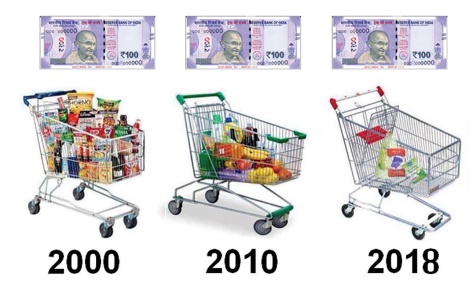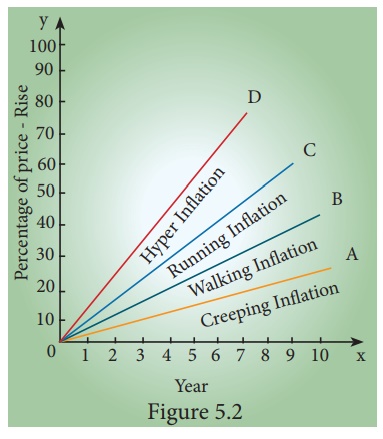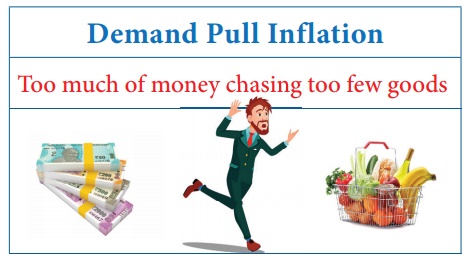Monetary Economics - Inflation: Meaning, Definitions, Types, Causes, Effects, Control | 12th Economics : Chapter 5 : Monetary Economics
Chapter: 12th Economics : Chapter 5 : Monetary Economics
Inflation: Meaning, Definitions, Types, Causes, Effects, Control
Inflation
Both inflation and deflations are evils of economy. So,
understanding of these is essential.
1. Meaning of Inflation
Inflation is a consistent and appreciable rise in the general
price level. In other words, inflation is the rate at which the general level
of prices for goods and services is rising and consequently the purchasing
power of currency is falling.

Definitions
“ Too much of Money chasing too few goods”
- Coulbourn
“A state of abnormal decrease in the quantity of purchasing power”
- Gregorye
2. Types of Inflation
On the basis of speed

(i) Creeping inflation (ii) Walking inflation (iii) Running
inflation and (iv) Galloping inflation or Hyper inflation.
The four types of inflation are indicated in Figure-5.2.
i) Creeping Inflation: Creeping inflation is slow-moving and
very mild. The rise in prices will not be perceptible but spread over a long
period. This type of inflation is in no way dangerous to the economy. This is
also known as mild inflation or moderate inflation.
ii) Walking Inflation: When prices rise moderately and the
annual inflation rate is a single digit ( 3% - 9%), it is called walking or
trolling inflation.
iii) Running Inflation: When prices rise rapidly like the running
of a horse at a rate of speed of 10% - 20% per annum, it is called
running inflation.
iv) Galloping inflation: Galloping inflation or hyper inflation points
out to unmanageably high inflation rates that run into two or three digits. By
high inflation the percentage of the same is almost 20% to 100% from an overall
perspective.
The first hyper inflation of the 21st century Zimbabwe’s annual
inflation rate surged to an unprecendented 3714 percent at the end of April
2007.
Demand-Pull Vs Cost-Push inflation
i) Demand-Pull Inflation: Demand and supply play a crucial role in
deciding the inflation levels in the society at all points of time. For
instance, if the demand is high for a product and supply is low, the price of
the products increases.

ii) Cost-Push Inflation: When the cost of raw materials and other
inputs rises inflation results. Increase in wages paid to labour also leads to
inflation.
Wage-Price Spiral
Wage-price spiral is used to explain the cause and effect
relationship between rising wages and rising prices or inflation.
Other types of inflation (on the basis of inducement)
i) Currency inflation: The excess supply of money in circulation
causes rise in price level.
ii) Credit inflation: When banks are liberal in lending credit,
the money supply increases and thereby rising prices.
iii) Deficit induced inflation: The deficit budget is generally financed
through printing of currency by the Central Bank. As a result, prices rise.
iv) Profit induced inflation: When the firms aim at higher profit, they
fix the price with higher margin. So prices go up.
v) Scarcity induced inflation: Scarcity of goods happens either due to
fall in production (eg. farm goods) or due to hoarding and black marketing.
This also pushes up the price. (This has happened is Venezula in the year 2018)
vi) Tax induced inflation: Increase in indirect taxes like excise
duty, custom duty and sales tax may lead to rise in price (eg. petrol and
diesel). This is also called taxflation.
3. Causes of Inflation
The main causes of inflation in India are as follows:
i) Increase in Money Supply: Inflation is caused by an increase in the
supply of money which leads to increase in aggregate demand. The higher the
growth rate of the nominal money supply, the higher is the rate of inflation.
ii) Increase in Disposable Income: When the
disposable income of the people increases, it raises their demand for goods and
services. Disposable income may increase with the rise in national income or
reduction in taxes or reduction in the saving of the people.
iii) Increase in
Public Expenditure:
Government activities have been expanding due to developmental
activities and social welfare programmes. This is also a cause for price rise.
iv) Increase in Consumer Spending: The demand for goods and
services increases when they are given credit to buy goods on hire-purchase and
installment basis.
v) Cheap Money Policy: Cheap money policy or the policy of
credit expansion also leads to increase in the money supply which raises the
demand for goods and services in the economy.
vi) Deficit Financing: In order to meet its mounting expenses,
the government resorts to deficit financing by borrowing from the public and
even by printing more notes. This raises aggregate demand in relation to
aggregate supply, thereby leading to inflationary rise in prices.
vii) Black Assests, Activities and Money: The existence of black
money and black assests due to corruption, tax evasion etc., increase the
aggregate demand. People spend such money, lavishly. Black marketing and
hoarding reduces the supply of goods. These trends tend to raise the price
level further.
viii) Repayment of Public Debt: Whenever the government repays its past internal
debt tothe public, it leads to increase in the money supply with the public.
This tends to raise the aggregate demand for goods and services.
ix) Increase in Exports: When exports are encouraged, domestic
supply of goods decline. So prices rise.
4. Effects of Inflation
The effects of inflation can be classified into two heads:
(1) Effects on Production and
(2) Effects on Distribution.
1. Effects on Production:
When the inflation is very moderate, it acts as an incentive to
traders and producers. This is particularly prior to full employment when
resources are not fully utilized. The profit due to rising prices encourages
and induces business class to increase their investments in production, leading
to generation of employment and income.
i) However, hyper-inflation results in a serious
depreciation of the value of money and it discourages savings on the part of
the public.
ii) When the value of money undergoes considerable
depreciation, this may even drain out the foreign capital already invested in
the country.
iii) With reduced capital accumulation, the investment will
suffer a serious set-back which may have an adverse effect on the volume of
production in the country. This may discourage entrepreneurs and business men
from taking business risk.
iv) Inflation also leads to hoarding of essential goods both
by the traders as well as the consumers and thus leading to still higher
inflation rate.
v) Inflation encourages investment in speculative activities
rather than productive purposes.
2. Effects on Distribution
i) Debtors and Creditors: During inflation, debtors are the gainers
while the creditors are losers. The reason is that the debtors had borrowed
when the purchasing power of money was high and now repay the loans when the
purchasing power of money is low due to rising prices.
ii) Fixed-income Groups: The fixed income groups are the worst hit
during inflation because their incomes being fixed do not bear any relationship
with the rising cost of living. Examples are wage, salary, pension, interest,
rent etc.
iii) Entrepreneurs: Inflation is the boon to the
entrepreneurs whether they are manufacturers, traders, merchants or
businessmen, because it serves as a tonic for business enterprise. They
experience windfall gains as the prices of their inventories (stocks) suddenly
go up.
iv) Investors: The investors, who generally invest in
fixed interest yielding bonds and securities have much to lose during
inflation. On the contrary those who invest in shares stand to gain by rich
dividends and appreciation in value of shares.
5. Measures to Control Inflation
Keynes and Milton Friedman together suggested three measures to
prevent and control of inflation.
i) Monetary measures,
ii) Fiscal measures (J.M. Keynes) and
iii) Other measures.
i) Monetary Measures: These measures are adopted by the Central
Bank of the country. They are (i) Increase in Bankrate (ii) Sale of Government
Securities in the Open Market (iii) Higher Cash Reserve Ratio (CRR) and
Statutory Liquidity Ratio (SLR) iv) Consumer Credit Control and Higher margin requirements
(vi) Higher Repo Rate and Reverse Repo Rate.
ii) Fiscal Measures: Fiscal policy is now recognized as an
important instrument to tackle an inflationary situation. The major
anti-inflationary fiscal measures are the following: Reduction of Government
Expenditure, Public Borrowing and Enhancing taxation.
iii) Other Measures: These measures can be divided broadly
into short-term and long-term measures.
a) Short-term measures can be in regard to public distribution
of scarce essential commodities through fair price shops (Rationing). In India
whenever shortage of basic goods has been felt, the government has resorted to
import so that inflation may not get triggered.
b) Long-term measures
will
require accelerating economic growth especially of the wage goods
which have a direct bearing on the general price and the cost of living. Some
restrictions on present consumption may help in improving saving and investment
which may be necessary for accelerating the rate of economic growth in the long
run.
Related Topics